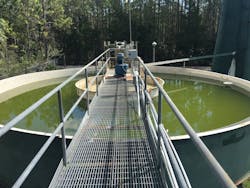Hole-in-One Treatment
Phil Locke, P.E., is senior project manager for McKim & Creed Inc. Locke can be reached at [email protected] or 727.442.7196. Eric Smith, P.E., is project engineer for McKim & Creed Inc. Smith can be reached at [email protected] or 386.274.2828.
undefinedPlantation Bay Golf & Country Club in Flagler County, Fla., is a private community featuring 45 holes of golf, 10 tennis courts, a pool pavilion, nature parks and walking trails. In the early 1980s, a private developer built the 756,000-gal-per-day (gpd) Plantation Bay Water Treatment Plant (PBWTP) to serve the approximately 1,600 residents. The facility utilizes four groundwater wells to produce average day and maximum day flows of 232,000 and 377,000 gpd, respectively.
Over the years, the PBWTP degraded. While all of the wells are moderately high in total hardness (approximately 325 mg/L as CaCO3), two of the wells began yielding water with high color that frequently approached 90 color units. The lime softening treatment process utilized at PBWTP became ineffective in removing the color, resulting in frequent complaints from customers and the inability to use the two wells. Additionally, PBWTP exceeded the U.S. EPA disinfection byproduct (DBP) mean contaminant levels of 80 µg/L for total trihalomethanes. Both the color and DBP formation issues stem from natural organic matter in the wells, resulting in total organic carbon levels as high as 25 mg/L.
Chemicals are added throughout the treatment process.
Time for an Upgrade
In 2013, Flagler County purchased the facility with the goal of improving water quality and bringing the plant back into regulatory compliance. To determine the best treatment solution, the county prepared a weighted treatment decision matrix to study potential alternatives.
Based on results from the evaluation, nanofiltration (NF) was selected for implementation to remove organics, color and hardness, and to reduce DBP formation potential. Concurrent with preliminary and final design, a pilot study was conducted using the well with the highest organics and color.
Based on the pilot testing and the design team’s experience with other facilities with similar water quality, the treatment processes will include oxidation, pressurized multimedia filtration, dechlorination, pH adjustment, antiscalent, cartridge filtration, membrane softening, permeate stabilization and disinfection. The system will include a two-stage NF system with an overall recovery of approximately 80%. A partial NF bypass stream is planned and will be used to add pH and alkalinity to the permeate water, resulting in lower chemical usage and operational costs. Because the chloride levels of the water supply are so low (approximately 25 mg/L), the concentrate from the NF system will be beneficially used for reuse water irrigation with no damage to plants, grass and other landscaping. The concentrate will be blended with the reclaimed water to supplement the county’s reclaimed water system that is used to irrigate the Plantation Bay Country Club. This approach to concentrate reuse also provides the benefit of eliminating the need for deep well injection or surface water discharge.
The new treatment facility will include a membrane softening process designed to remove hardness, organics, color and other contaminants. The NF process will include three skids capable of producing a combined 756,000 gpd of finished water. The process will be expandable to 1 million gal per day as demands increase. A brief description of the major components of the reverse osmosis (RO) process is as follows.
An inline booster pump station will be constructed and will include three pumps to provide ample feed pressure to the pressurized filters so that a minimum of 20 psi is available at the suction side of the NF feed pumps.
Three vertical pressure filters will be installed upstream of the RO skids as a means of pretreating the raw water. The filters will mainly serve to remove iron so as to mitigate iron fouling, which typically occurs on the lead elements of the first NF stage. Sodium hypochlorite will be used as an oxidant to aid in iron removal.
Via a membrane separation process, the NF membranes will treat the filtered water to meet all drinking water standards. NF will remove the color and allow some hardness and alkalinity to pass through the process, thereby reducing costs associated with post-treatment stabilization. The NF skids will include 5-µ cartridge filters to further protect the membranes, and high-pressure feed pumps to provide approximately 90 psi at the membrane inlet. A clean-in-place skid will provide for periodic cleaning using high pH solutions for biofouling and lowering pH solutions to remove scaling.
The treatment system is designed to remove color from the raw water.
Tackling Treatment
As previously mentioned, chemicals will be added throughout the treatment process as a means of enhancing the overall treatment and end-water quality. The chemicals that will be used for the new treatment process include:
- Oxidant. Sodium hypochlorite will be added to the raw water line prior to the vertical pressure filters to aid in iron removal.
- Dechlorination. The filtered effluent will be dechlorinated using sodium metabisulfite prior to introduction into the NF membranes.
- Anti-scalant. To protect the membranes from scaling, an anti-scalant will be added to the filtered effluent ahead of the RO treatment process.
- Caustic. Sodium hydroxide will be added to the RO permeate stream to increase the pH and alkalinity.
Additional space will be provided for a future chemical as needed.
The project also includes a new prefabricated metal building, replacement of the existing filter backwash pumps, yard piping modifications, site improvements, instrumentation and electrical improvements.
The county initiated construction in the second quarter of 2018, with facility completion scheduled by mid-2019.
